How to Tell If Semi-Freestone Peaches Are Ripe
Assessing Perfect Ripeness Indicators
Semi-freestone peaches offer a delightful blend of flavor and practicality, bridging the gap between clingstone and freestone varieties. Recognizing the ripeness of semi-freestone peaches is essential for both home consumers and professional chefs who seek the perfect balance of sweetness and texture for their culinary creations. When it’s time to enjoy these luscious fruits, knowing the signs of peak ripeness can enhance the experience and ensure the best use of the peach in recipes.
Ripeness in semi-freestone peaches is detected through a few telltale signs. The skin around the stem is a reliable indicator, as it reveals the true color unaffected by sunlight. A ripe peach in this category will typically show a deep yellow color, absent of green tinges, hinting at readiness for consumption. Additionally, ripeness is accompanied by a gentle give under slight pressure, emitting a sweet fragrance. These sensory checks are crucial, as semi-freestone peaches have a varied timeline of maturation, and each variety may present subtle differences in cues of ripeness.
Key Takeaways
Semi-freestone peaches are ideal for both raw consumption and culinary use, valued for their flavor and easy-to-remove pits.
Ripeness is indicated by color changes near the stem, softness to the touch, and a noticeably sweet aroma.
Proper storage can extend the shelf life while understanding seasonal availability supports sustainable sourcing.
Understanding Peach Varieties
When selecting peaches, it's important to understand the differences among freestone, clingstone, and semi-freestone varieties. Each has distinct characteristics that affect how they can be used and enjoyed.
Differences Between Freestone, Clingstone, and Semi-Freestone Peaches
Freestone Peaches:
Firmness: Generally have firmer flesh.
Usage: Ideal for eating fresh, baking, and canning.
Pit Removal: The pit (stone) easily separates from the flesh.
Examples: Cresthaven, Elberta, and Redhaven.
Clingstone Peaches:
Firmness: Often have juicier, softer flesh.
Usage: Commonly used for commercial canning and making preserves.
Pit Removal: The flesh clings to the pit, making it harder to remove.
Examples: Georgia Peach, Babygold.
Semi-Freestone Peaches:
Firmness: Blend the juiciness of clingstones with the easier pit removal of freestones.
Usage: Versatile, used fresh, for baking, canning, or preserving.
Pit Removal: The pit is easier to remove than clingstones, especially when fully ripe.
Examples: Redskin Peach, Coral Star.
Popular Peach Varieties and Their Characteristics
Elberta:
Flesh: Freestone, yellow.
Ripening Season: Late July to early August.
Use: Highly favored for canning and baking.
Redhaven:
Flesh: Freestone, firm, yellow.
Ripening Season: Mid-season.
Use: Excellent for fresh eating, canning, and freezing.
Cresthaven:
Flesh: Freestone, firm, yellow with red blush.
Ripening Season: Late season.
Use: Great for fresh consumption and preserving.
Babcock Peach (White Peach):
Flesh: Semi-freestone, white, sweet, and low in acidity.
Ripening Season: Early to mid-summer.
Use: Ideal for fresh eating.
Georgia Peach (Clingstone):
Flesh: Clingstone, known for its sweetness.
Ripening Season: Typically peaks in mid-July.
Use: Preferred for desserts and canning.
Coral Star:
Flesh: Semi-freestone, large, and yellow.
Ripening Season: Mid to late season.
Use: Suitable for all purposes including fresh eating and canning.
Redskin:
Flesh: Freestone, known for its attractive red skin and sweet flesh.
Ripening Season: Ripens in late July.
Use: Enjoyed fresh, and also good for baking and canning.
Understanding these categories and characteristics helps in making informed decisions whether you're a home gardener selecting varieties for your orchard or a consumer choosing the best peaches for your intended use.
Assessing Ripeness of Semi-Freestone Peaches
Assessing the ripeness of semi-freestone peaches involves a careful inspection of their color, aroma, and texture. A ripe peach should possess a rich hue, a sweet aroma, and a firm yet slightly yielding texture.
Identifying Ripe Peaches by Color and Aroma
Color: The skin of a ripe semi-freestone peach typically displays a deep yellow or golden color. The portion around the stem, less exposed to sunlight, should lack green undertones. A subtle blush may also be present, depending on the variety.
Aroma: Ripe peaches emit a sweet and floral fragrance. A fully ripe semi-freestone peach will have a stronger, more noticeable aroma indicating high sugar content.
Understanding the Scale of Peach Firmness
Ripe peaches have a characteristic firmness; they are not too hard nor too soft. A ripe semi-freestone peach should:
Feel firm but give a little under gentle pressure near the stem.
Not feel mushy or excessively soft as overripe peaches do.
Avoid too-hard peaches, as they may not have reached peak ripeness and flavor.
Sugar Content and Flavor as Indicators of Ripeness
Sugar Content: As peaches ripen, their sugar content increases providing sweetness. One can infer higher sugar levels in a peach when it begins to soften slightly but still retains some firmness.
Flavor: A ripe semi-freestone peach should taste sweet with a balance of acidity. The flavors are most fully developed when the peach is neither underripe nor overripe.
By being attentive to these characteristics, one can accurately gauge the ripeness of semi-freestone peaches and enjoy them at their peak of flavor.
Culinary Uses of Semi-Freestone Peaches
Semi-freestone peaches offer a balance between the flavor and textural merits of clingstone and freestone peaches, making them a versatile choice for various culinary applications. Their sweet taste and relatively easy stone removal upon ripening are ideal for baking and preservation practices like canning and freezing.
Best Practices for Baking with Semi-Freestone Peaches
When baking with semi-freestone peaches, it is important to choose fruit that provides both flavor and structure. These peaches are known for their sweetness and juiciness, which can enhance pies, cobblers, and other baked goods. Here are some tips for baking:
Preparation: Wash the peaches thoroughly. To remove the pit, cut along the seam and twist the halves. If the peach is ripe the stone should come out with minimal effort.
Slicing: Uniform slices ensure even baking. Aim for about 1/4–1/2 inch thick slices.
Preventing Browning: Toss the slices in a mixture of lemon juice and water or coat them with sugar to prevent oxidation.
For consistent results, it's recommended to adjust the amount of sugar based on the natural sweetness of the peaches and to consider pre-cooking the filling to reduce excess moisture.
Canning and Freezing Semi-Freestone Peaches
Semi-freestone peaches can be preserved through canning and freezing, extending their shelf life and allowing for future use without significant loss of quality.
Canning:
Sanitize jars and lids before use to prevent contamination.
Blanch and Peel: Briefly blanch the peaches in hot water and then transfer them to cold water to loosen the skins.
Syrup: Pack the peaches in jars with a simple syrup to help maintain texture and flavor.
Keep in mind that the syrup's sugar concentration can be adjusted based on preference, ranging from light to heavy.
Freezing:
Prep: Blanch peaches to remove the skins, and then slice. Pits should be removed following the same method as baking.
Protect: Coat peach slices in a solution of ascorbic acid or use sugar to minimize browning.
Storage: Place the prepared slices flat on a baking sheet lined with parchment until they are frozen solid, then transfer to airtight containers or freezer bags.
Freezing peaches this way helps retain their quality and prevents the slices from sticking together, making it easy to use the desired amount later.
Storage and Shelf Life of Semi-Freestone Peaches
Semi-freestone peaches offer a balance between firm attachment to the stone and ease of separation. When it comes to storing these peaches, there are key practices to ensure their longevity and freshness.
At room temperature, semi-freestone peaches can continue to ripen. They should be placed in a single layer, away from direct sunlight, and checked daily. Once these peaches reach optimal ripeness, their shelf life can be extended by refrigeration.
Refrigeration can slow down the ripening process, preserving the peaches for longer. However, they are best consumed within:
3 to 5 days post-ripening when kept at a consistent temperature in the refrigerator.
To prepare semi-freestone peaches for longer storage, they can be:
Washed and dried thoroughly.
Sliced and treated with ascorbic acid to prevent browning.
Placed in an airtight container or freezer bag.
For freezing, these steps help maintain quality:
The peaches should be frozen in a single layer on a baking sheet before transferring to a container, to prevent clumping.
In the freezer, semi-freestone peaches can retain quality for:
Up to 6 months, although they remain safe to eat beyond that time frame.
Humidity levels should be controlled to prevent moisture from affecting the fruit’s texture. It’s essential for consumers to regularly inspect stored peaches for any signs of spoilage, such as mold or unusual odors, which can reduce their shelf life.
Sourcing Semi-Freestone Peaches
When seeking semi-freestone peaches, it's essential to consider the regional differences in peach orchards, understand the ideal season, and know where to find them at local markets.
Regional Variations in Peach Orchards
Peach orchards thrive in various regions, each imparting unique characteristics to the peaches they produce. Georgia and South Carolina are renowned for their juicy, high-quality peaches. California stands as a major producer, with its Central Valley orchards yielding large quantities. The Michigan and Texas climates also support peach cultivation, albeit with distinct flavor profiles and harvesting periods. The semi-freestone peaches from these areas offer a blend of the clingstone peach's juiciness and the freestone's ease of pit removal.
Timing and Locations for Peak Peach Season
The peak season for semi-freestone peaches typically falls between late July and August. However, the exact timing can vary by region:
Georgia: Early to mid-August
California: July through September
South Carolina: Late July to early August
Michigan and Texas: Early August
During these times, orchards often welcome the public for peach picking, providing farm-fresh fruit straight from the tree.
Finding Semi-Freestone Peaches at Local Markets
Farmer's markets are ideal venues for locating fresh semi-freestone peaches, allowing buyers to speak directly with growers. Here is a guide for market-goers:
Local Farmer's Market:
Check for availability in late summer.
Ask vendors for specific peach varieties.
Specialty Stores:
Look for regional produce featuring semi-freestone peaches.
Enquire about the source to ensure you're getting fresh, local fruit.
Remember, the availability at markets can depend on regional harvest times and conditions.
Understanding the Role of Peaches in Agriculture
Peaches are a significant stone fruit crop with substantial agricultural implications. In the United States, states like Georgia, California, Michigan, and Texas are well-known for their peach production.
California ranks as the leading peach producer in the country, offering a large variety of both clingstone and freestone peaches. Following closely, Georgia, known as 'The Peach State,' has historically been recognized for its high-quality peaches. Other states like Michigan and Texas also contribute to the peach supply but on a smaller scale in comparison to California and Georgia. The success in these regions is partly due to favorable climates and soil conditions conducive to peach growth.
Internationally, China stands as the world's largest producer of peaches, playing a vital role in the global peach economy.
California
Role in Peach Agriculture: Leading producer in the US; diverse varieties
Georgia
Role in Peach Agriculture: High-quality peaches; historic relevance
Michigan
Role in Peach Agriculture: Smaller scale production; regional contributions
Texas
Role in Peach Agriculture: Part of the peach supply chain; regional contributions
China
Role in Peach Agriculture: Largest global producer
In agriculture, peaches provide a valuable commodity for both fresh consumption and processing. Varieties like semi-freestone peaches cater to consumer preferences, offering easy-to-remove pits and versatility in use, from fresh eating to baking and canning.
The economic impact of peach agriculture becomes evident when examining the increase in production value over time. Despite a gradual decline in bearing acreage of peach trees over four decades, the value of production has climbed. This suggests market resilience and growing consumer demand.





